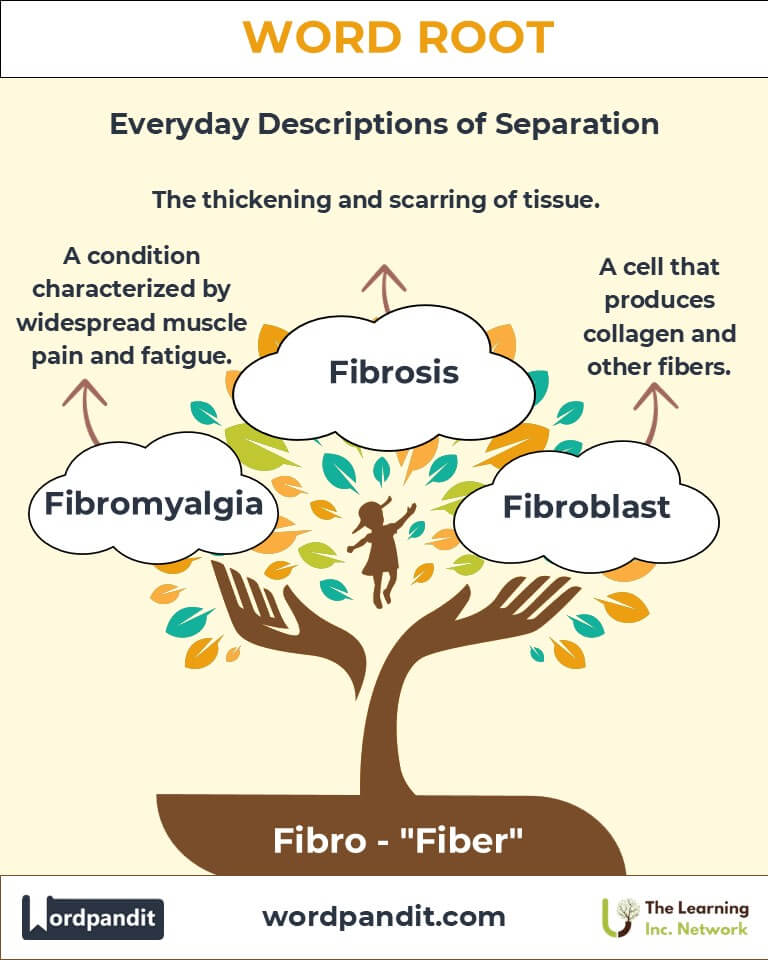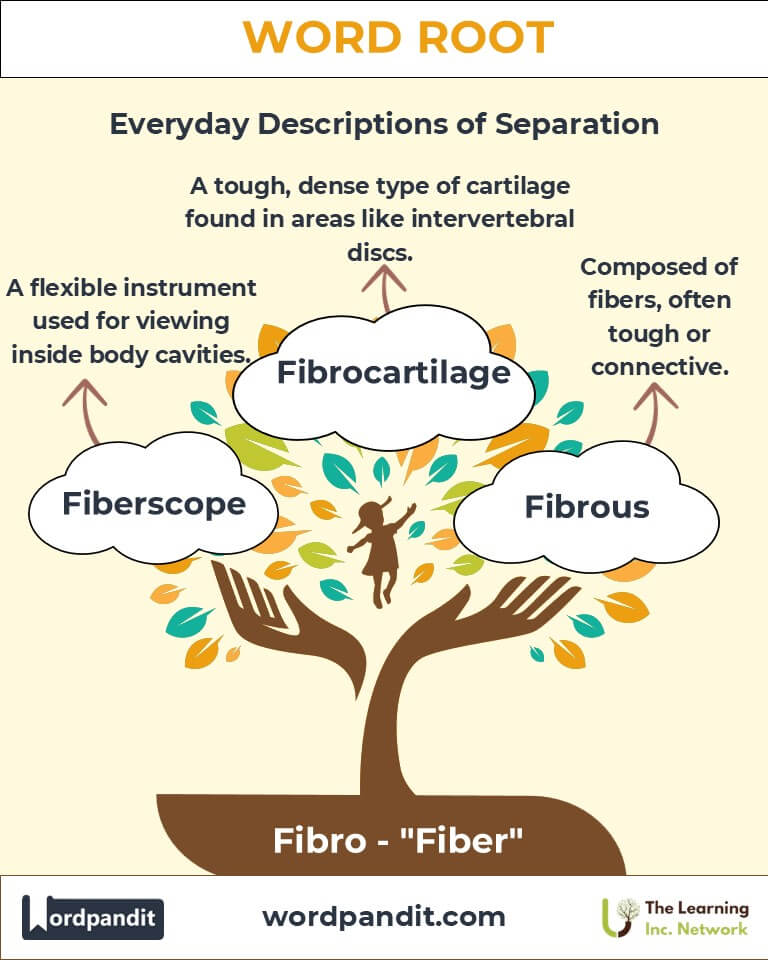Fibro: The Root of Fiber in Biology and Medicine
Explore the fascinating root "fibro," derived from the Latin word fibra, meaning "fiber." From medical terms like "fibrosis" to biological ones like "fibroblast," this root highlights the thread-like structures that form the foundation of life and health.

Table of Contents
- Introduction: The Essence of "Fibro"
- Etymology and Historical Journey
- Mnemonic: Unlocking the Power of Fibro
- Common Fibro-Related Terms
- Fibro Through Time
- Fibro in Specialized Fields
- Illustrative Story: Fibro in Action
- Cultural Significance of the Fibro Root
- The Fibro Family Tree
- FAQs about the Fibro Word Root
- Test Your Knowledge: Fibro Mastery Quiz
- Conclusion: The Thread of Fibro in Life
Introduction: The Essence of "Fibro"
The root "fibro," derived from the Latin fibra (fiber), encapsulates the essence of thread-like structures that support and connect tissues in living organisms. Found predominantly in medical and biological terminology, "fibro" signifies the importance of fibers in forming connective tissues, repairing wounds, and ensuring the integrity of various body systems.

Etymology and Historical Journey
The word root "fibro" comes from the Latin fibra, meaning "fiber" or "thread." Historically, fibra was used to describe thin, thread-like structures in both natural and man-made contexts. As medical and biological sciences advanced, the term was adopted to describe fibrous tissues and cells in living organisms, emphasizing their role in structure and healing.
Mnemonic: Unlocking the Power of Fibro
To remember "fibro," visualize a spider weaving a web of delicate fibers, each thread contributing to the strength and structure of the whole.
Mnemonic Device: "Fibro forms the threads of life, weaving strength and support in tissues."
Common Fibro-Related Terms
- Fibrosis (fy-BROH-sis): The thickening or scarring of connective tissue, often due to injury or disease.
- Example: "Pulmonary fibrosis affects the lungs, making breathing difficult."
- Fibroblast (FY-bro-blast): A cell that produces collagen and other fibers essential for connective tissue.
- Example: "Fibroblasts play a vital role in wound healing by generating new tissue."
Fibro Through Time
- Fibrosis: Initially associated with scarring after injuries, the term now encompasses chronic conditions like pulmonary fibrosis, where excessive scar tissue disrupts normal function.
- Fibroblast: First recognized in the 19th century, fibroblasts are now central to regenerative medicine and tissue engineering.
Fibro in Specialized Fields
- Medicine: Fibrosis is key in understanding chronic conditions like liver cirrhosis and pulmonary fibrosis.
- Biology: Fibroblasts are essential for tissue repair and maintaining structural integrity.
Illustrative Story: Fibro in Action
Dr. Elena, a biologist specializing in wound healing, studied fibroblasts to understand how these cells repair tissue. When her patient, Tom, suffered a severe burn, she applied her research to develop a treatment that stimulated fibroblast activity. Over time, Tom’s wounds healed, leaving minimal scarring. This experience underscored how "fibro" connects science to real-life healing.
Cultural Significance of the Fibro Root
While "fibro" is primarily scientific, its metaphorical significance as a "thread" or "connector" resonates in art and culture. In weaving and fabric-making, fibers represent connection and strength. Similarly, in biological terms, fibro-related structures symbolize the interconnectedness and resilience of life.

The Fibro Family Tree
Here are some related roots and prefixes that enrich the "fibro" family:
- Collagen- (from Greek "kolla," glue):
- Collagen: The main structural protein in connective tissues.
- My- (from Greek "mys," muscle):
- Myofibers: Muscle fibers involved in movement and strength.
- Elastic- (from Greek "elastikos," flexible):
- Elastin: A protein allowing tissues to stretch and return to their shape.

FAQs About the "Fibro" Root
Q: What does "fibro" mean?
A: The root "fibro" comes from the Latin word "fibra," meaning "fiber" or "thread." It refers to thin, thread-like structures that provide support, flexibility, and connectivity in biological tissues. These fibers are foundational to the body’s structural integrity, wound repair, and tissue function.
Q: What is fibrosis, and how does it affect the body?
A: Fibrosis is the formation of excessive fibrous connective tissue, often as a result of injury, inflammation, or chronic disease. While it is part of the body's natural healing process, excessive fibrosis can disrupt normal organ function, as seen in conditions like pulmonary fibrosis (affecting the lungs) or liver fibrosis (affecting the liver).
Q: What role do fibroblasts play in the body?
A: Fibroblasts are specialized cells responsible for producing collagen and extracellular matrix components. They are crucial for maintaining the structural framework of connective tissues and play a pivotal role in wound healing by generating new fibers to repair damaged tissue.
Q: How does fibromyalgia relate to the fibro root?
A: Fibromyalgia is a chronic condition characterized by widespread pain in the fibrous tissues (like muscles, tendons, and ligaments). While the exact cause is unclear, it reflects the root's connection to fibers that make up these tissues, which are often tender and sensitive in affected individuals.
Q: Are fibroids cancerous?
A: No, fibroids are benign (non-cancerous) tumors made up of fibrous connective tissue and smooth muscle cells. Although they are not cancerous, uterine fibroids, for instance, can cause discomfort, heavy menstrual bleeding, and other complications depending on their size and location.
Q: What is fibronectin, and why is it important?
A: Fibronectin is a glycoprotein found in the extracellular matrix. It plays a vital role in cell adhesion, migration, and tissue repair. During wound healing, fibronectin acts as a scaffold, helping cells migrate to the damaged area and promoting the regeneration of tissues.
Test Your Knowledge: Fibro Mastery Quiz
1. What does the root "fibro" signify?
2. Which cell is responsible for producing connective tissue fibers?
3. What is fibrosis?
4. Which protein aids cell adhesion in wound healing?
5. What condition affects fibrous tissues and causes widespread pain?
Conclusion: The Thread of Fibro in Life
The root "fibro" symbolizes the fibers that weave life together, from the collagen in our skin to the scar tissue that heals wounds. Its significance in biology and medicine underscores its vital role in health and resilience. As we continue to explore "fibro," we gain deeper insights into the threads that connect and support the living world.












